




The trial’s main objectives are to ascertain how well flax grows in a range of soil types, measured by crop establishment and yield; and to compare the performance of 3 varieties in a range of soil types.
The secondary objectives are to explore factors which may influence the retting process (e.g. time retted, number of turnings, weather); and to compare the fibre quality of 3 varieties.
In the second year the trial also looked at ways of reducing weed burden in flax, and included two growers from England.
Click on the brown banner above for latest activity and other information
Year 1:
There will be three main trial sites. Each site will grow 3 replicates of each variety (Avian, Delta, Tango) on 10sqm plots, totalling 9 plots per site. Plots will be randomised in three reps. Seed will be sown in rows 125mm apart at a rate of ~10g/sqm.
None of these varieties are commercially available in the UK yet.
Other community growers will also be encouraged to take part in a wider, support trial.
The field lab will follow the production process from seed to harvested crop; measuring establishment & yield and comparing these across varieties and sites.
The seeds for the trial are being provided by Elsoms Seeds.
Year 2:
In the second year a further nine triallists joined the field lab, two of which were in England, the rest in Scotland. The trial design is similar but This time the triallists will focus on height and yield. In addition to variety trials the triallists will also be looking at weed burden by under-sowing the flax with Rivendale micro-leaved clover.
It's with great excitement that we can annouce a year's extension to the flax field lab. This final, third year of trials will involve all of the three farms growing the same three flax varieties.
One benefit of a third year is that the scientific data that James Hutton Institute has to analyse will be more robust.
It will also allow the group to experiment with the retting following harvest, to work out the optimal timings.
And Lauriston Farm will be growing a half acre plot, and will trial baling.
The flax seeds will be sown over the next couple of weeks at all three sites.
In addition to the trials, Rosie Bristow of the Fantasy Fibre Mill will be processing last year's flax over the coming months. It is hoped that her work will give insights into the different properties of the fibres from each of the different varieties.
An interim report will be produced soon to present the data from the 2024 trial.
At the start of December, triallists from the Fibre Flax Field Lab met for a final meeting at Phantassie Farm in East Lothian to explore the trial results, plan next steps, and have a tour of Fantasy Fibre Mill, where the trial crop is being processed into linen yarn.

In this second year the trial grew from 3 to 7 sites in Scotland, with two partner sites in the south of England as well.
Headline results are that all 3 varieties – Avian, Delta and Tango - did well across all sites, and despite the wet summer grew taller and yielded better on average compared to last year. Overall, the Delta variety performed slightly better than Avian and Tango.
The group is keen to continue the trial for one more year, in which we will also look in more detail at the post-harvest retting process, approaches to scaling up fibre flax production, and routes to market.
Full analysis of the trial results will be available in the final report, which will be published soon – look out for it here on the field lab page.
In August we updated that the fibre flax harvest, although late, was underway.
The crop has been weighed, measured and has now mostly finished the retting process – in which the woody fibres in the stem are broken down to allow the flexible part of the fibre to be processed. Over the next few months, it will be processed into yarn by project partner Fantasy Fibre Mill – based at Phantassie Farm in East Lothian.
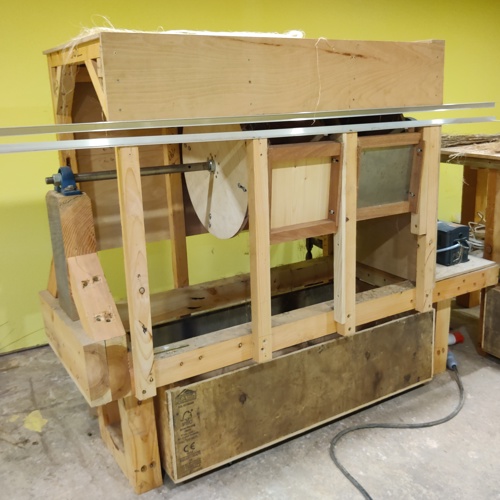
While we were harvesting the crop at Phantassie, we were delighted to be joined by the BBC Landward crew, where presenter Anne tried her hand at harvesting – you can watch the full episode here (skip to 21:10 for the flax segment).

We are now working through the 2024 harvest data, and plan to publish the results in December – look for it here on the field lab page, where you can also find recent blogs and more info about the project.
The Scottish flax fibre field lab has learned a lot this year, testing three fibre varieties to see which works best in Scottish soils and climate. Watch the post-harvest video here.
The flax crop was harvested in August (see previous update for details), and has now been retted, dried, and transported to project partners at Edinburgh College of Art Textiles Department and Fantasy Fibre Mill for extracting the fibre, spinning, weaving and experimenting over the winter months. Some will also stay at one of the trial sites, Lauriston Farm, for on-site processing workshops.
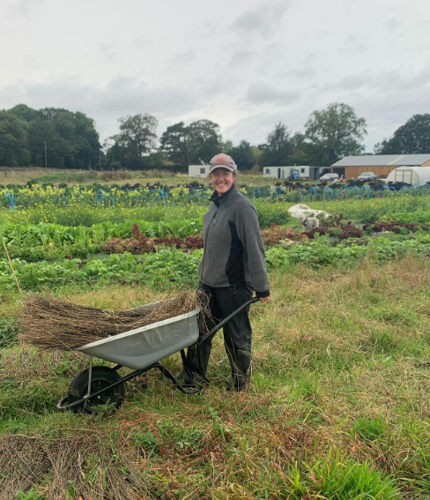
Retting is the process by which bacteria and water break down the woody stem (lignins and pectins) of the plant by laying it out in the field and turned for several weeks, and is a bit of a fine art. We are confident that most of the crop looks well retted but, with the changeable and often wet weather in September, it is quite possible that some of the flax has been over-retted. When this is the case, the over-retted bits will be brittle, and break into short fibres during processing rather than staying long and flexible. These short fibres can still be utilised in other ways (e.g. as animal bedding), but are not suitable for textile production. The fibre quality will become apparent during the processing (and be tested by project partners Heriot Watt University), and we will be able to refine our processes for next year.
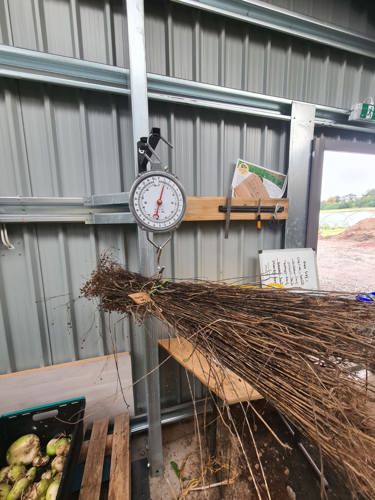
A range of yields between 8–12t/ha was recorded across varieties and sites which, by all accounts, is pretty good; and one variety consistently measured shorter in height at all three sites. The harvest data is awaiting statistical analysis, which will show whether the differences in height and yield between varieties are significant.
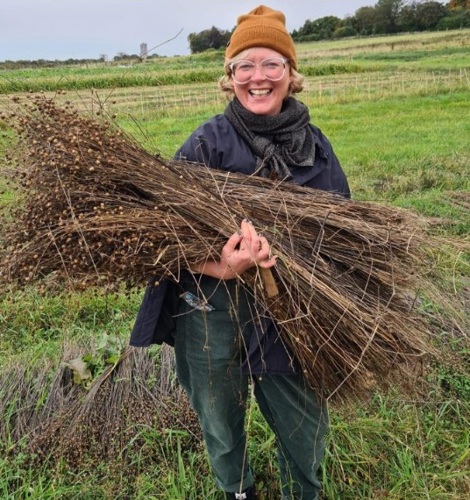
Plans are also underway to expand the field lab in 2024 by trialling the same three varieties – Avian, Delta and Tango – at more sites; refining the parameters based on what we learned this year and making the initial results more robust. Any reliable information we can share with the wider farming community on the performance of these new varieties, will be useful in supporting potential growers as well as the emerging flax and linen processing and supply chain.
View the time lapse harvest video here: Time lapse video of harvest
The flax has now been hand harvested on the three trial farms and took slightly longer than the recommended 100 days to mature. It is possible that drought in the spring/early summer and cooler temperatures in July may have affected growth and ripening.
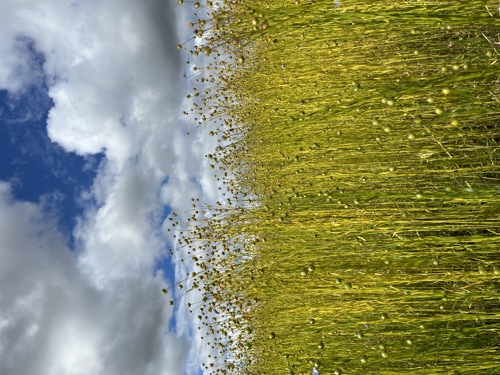
The crop is ready to pull around 40 days after flowering, when the seed pods have changed from pale to brown and the stem has started to yellow. At this stage, the seed heads are not yet ripe but the flexible fibre in the stem is at its strongest for being processed into textiles. If over-ripe, the inner fibres break easily and become more difficult to process.

Plants are pulled by hand to ensure maximum fibre length, as the fibre extends down into the root. It is then laid out on the ground with roots at one end and seed pods at the other, in a process known as retting (old Scots word for rotting) – where soil microbes and moisture in the damp ground break down the lignins and pectins in the woody stem, allowing the flexible fibres to be extracted for processing.
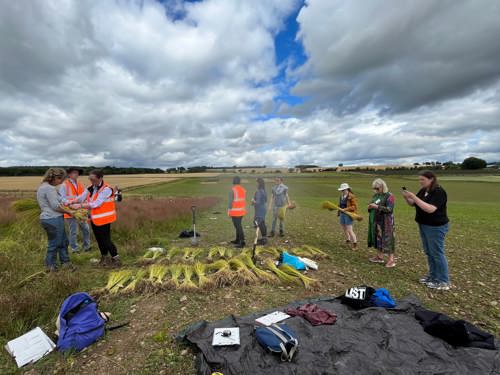
After 10 to 20 days the crop is turned to allow the top layer to become damp and ret. The whole process is weather dependent and can take from two weeks to two months depending on conditions. When the crop is fully retted it needs to be dried and stored, ready to be processed and spun into yarn for weaving.
The main factors assessed were yield, crop height (which informs the fibre length), crop density (number of plants per plot) and crop weight (thicker stems might imply better quality fibre). A good crop would have tall, thick stems growing densely together.
We also wanted to know what factors may influence germination and growth (and whether this has a bearing to final yield), so recorded soil type, measured soil health and compared weed pressure.
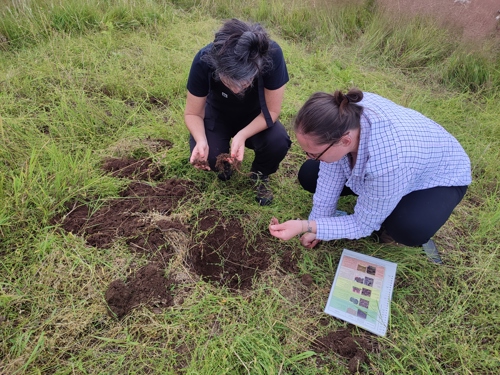
Observations were also made of differing root structure – ideally as little soil as possible will come up with the roots.
Of the three varieties, one appears to have performed less well than the other two, growing consistently shorter and less dense across all three sites
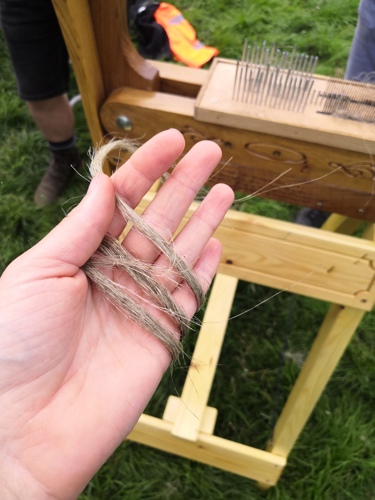
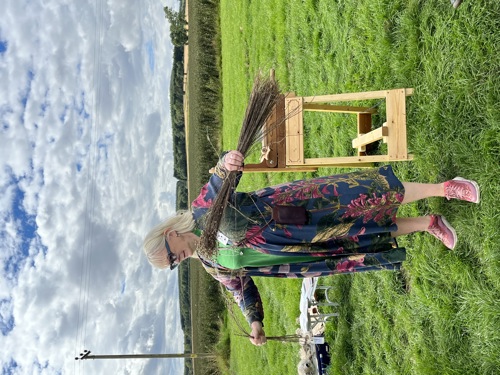
This Innovative Farmers field lab is the first small step in a process that project participants and collaborators hope will be the start of the development and re-establishment of a thriving sustainable textile economy in Scotland (and the UK). There is a growing network of actors contributing to this work (e.g. the newly-established Fibreshed Scotland, Fantasy Fibre Mill, farmers who are interested in growing flax on a commercial scale, Journeys in Design/Flax Futures); and we hope that by working together we can develop a sustainable Scottish textile industry which empowers everyone in the processing and supply network.
If you want to get involved in the future – contact info@innovativefarmers.org to find out the latest.
The initial core group of three farmers, researchers from James Hutton Institute and Edinburgh College of Art has grown throughout the project and now also includes 30 community growers and a growing network of collaborators including a flax to yarn processing mill start-up – Fantasy Fibre Mill, spinners, weavers, dyers, educators, crafters and textile researchers.
The flax is now in the ground: three varieties across the three trial sites. There are also 30 community plots across Scotland taking part in the trials. The next stage will be in July / August when the flax will flower and then it will be harvest time.
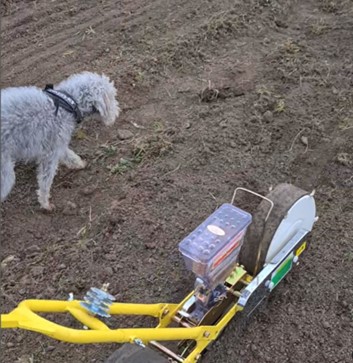
Trial plot being sown - photo from Lauriston Farm
May 2023
August 2023
September 2023
October 2023
December 2023
March 2024

Colleen McCulloch
Scotland
Colleen McCulloch is an independent facilitator, consultant and project manager, specialising in agroecological food & farming systems. Formerly Soil Association Scotland’s senior farming programmes manager, she has spent the last 10 years building, supporting and mobilising farmer-led innovation groups and networks across Scotland and the UK. This has involved many inspiring projects, including leadership of Scotland’s Rural Innovation Support Service - a national collaboration which ‘connected farmers and supply chain actors to develop innovative projects, that delivered sustainable solutions to real world challenges’. Colleen has a mixed background in organic farming, research and ecology; and combines these to support the transition towards more organic and agroecological food production.

Aberdeen